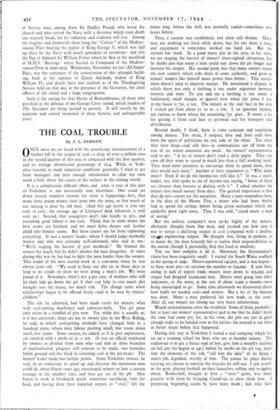MALTA THE INDOMITABLE
By CANON R. M. NICHOLLS
IT is welcome news that The Spectator has undertaken to raise Lz,000 for a Shrine of Remembrance in St. Paul's Anglican Cathedral, Malta, in connexion with the general appeal for the English cathedrals in Gibraltar and Malta. I had the privilege of serving as Chancellor (Canon in Charge) of St. Paul's, Malta, from 193i till the early summer of 1942, when I was peremptorily invalided home. Everyone knows something of the siege of that dauntless island ; the ' Illustrious ' blitz and the epic of H.M.S. ' Penelope ' have been published to the world. But perhaps not everybody realises that Malta was always an aggressive base for submarines, bombers, and a small but very vigilant and successful naval force. Had it fallen, it is probable that Rommel, with undisturbed communication with Italy, might have built up his army and his stores effectively enough to have occupied Egypt before we were ready to attack at El Alamein and make the African landings ; and Malta was within an ace of capture by starvation.
The Germans realised it clearly enough, and from June, 194o, till the siege was raised in the autumn of 1942 they made every effort to bomb us into submission. Except for occasional periods when the Luftwaffe was otherwise employed, as in the opening phase of the war against Russia and the capture of Crete, we were bombed almost continuously day and night. The glorious auberges of the Knights of St. John were wrecked, gutted or blasted: the dockyard and the naval hospital, with the populous towns around them, were reduced to rubble ; the submarine base was demolished piecemeal by accurate bombing. A proportion of the convoys which brought us food, ammunition and fuel got through : but many of the ships (modern fast freighters) were sunk with their priceless cargoes, and many of the warships which escorted them. Withcut their heroic labours the island had certainly been lost. And, all the time, the meagre allowance of out-of-date fighter aircraft (all that could be spared) was engaging superior forces, while soldiers patched up the airfields for the nightly bombing of Sicily.
Amidst all this dust and smother and roar—and right in the centre of it—the Anglican Cathedral stood fast. Bombs must have missed its high-pitched roof by a few feet over and over again. The roof of the Chancellor's House (which forms part of the Cathedral) was twice removed: the historic seventeenth-century organ was silenced and all the well-known effects of blasting endured. Around it were huge bomb-craters or damaged buildings ; but it received only one direct hit. This was at the base of the spire, which rises to a great height upon a Renaissance tower and is a landmark for ships entering harbour. A huge chunk of stone was bitten out of the base, but the tower stood. As the building stood firm, so did that Church of England which the fabric symbolised. The services and ministrations were regularly held on weekdays and Sundays. The congregations were thin, for the warriors could not quit their posts and the civilians dared not go far from their shelters. Nevertheless the services were held, at first in the nave, until the alert drove us in orderly fashion to the massive partly-underground crypt below. Soon an altar was set up, and all services were held there. Often the minister had to shout at the top of his voice to overcome the roar of what was then the heaviest barrage in Europe and the crash of falling bombs. On Easter Day, 1942, a gallant band of twenty worshippers crouched in the remotest corner with their hearts in their mouths.
The 2345,000 Maltese are Roman Catholics all, and, of course, make no use of the cathedral, though an exception was made when Sir Walter Congreve, Governor of the island, died in harness and 30,000 Maltese passed through the church at his lying-in-state. But St. Paul's has a definite place in the life of the English community. There are official pews for the Governor, the Commander-in-Chief of the Mediterranean Fleet (who is ex officio a trustee of the building), the Lieutenant-Governor, and the Air Officer Commanding. I recall many solemn services with great congregations. Among them, Armistice Day in the years when it was officially kept ; that Sunday which completed the week of Jubilee of King George V of blessed memory ; memorial services for Sir David Campbell (Governor), for Lord Jellicoe, Lord Beatty and—most poignant of all—King George V. Many marriages have been celebrated there, especially
of Service men, among them Sir Dudley Pound, who loved the church and who served the Navy with a devotion which even death can scarcely break, for his influence and tradition still live. Among the trophies and memorials there hang the " Colour " of the Mediter- ranean Fleet bearing the cipher of King George V, which was laid up there by the Navy with much splendour of ceremony: and also the flag of Admiral Sir William Fisher which he flew at the masthead of H.M.S. ' Revenge ' when Second in Command of the Mediter- ranean Fleet in 1930-1932. Wednesday, November 1st last (All Saints' Day), was the centenary of the consecration of this splendid build- ing, built at the expense of Queen Adelaide, widow of King William IV, and details have just reached us of the Thanksgiving Service held on that day' in the presence of the Governor, the chief officers of the island and a large congregation.
Such is the setting for that Shrine of Remembrance, of those who perished in the defence of the George Cross island, which readers of The Spectator are being invited to present. It will clearly be the supreme and central memorial of those historic and unforgettable years.



























 Previous page
Previous page